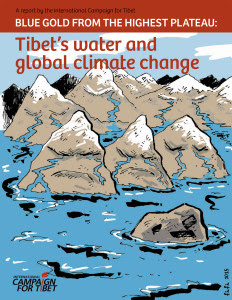
DHARAMSHALA: International Campaign for Tibet (ICT), a global advocacy group for Tibet launched a new report ‘Blue gold from the highest plateau: Tibet’s water and global climate change’ on 8 December in Paris, criticising the Chinese government for the devastating consequences of its policies which are re-shaping the landscape of the earth’s highest and largest plateau.
Matteo Mecacci, President of ICT said: “As talks began in Paris, both the Dalai Lama and the Beijing leadership have expressed alarm about the scale of the environmental crisis in Tibet, the ‘Roof of the World’. Known as the earth’s ‘Third Pole’, because it contains the biggest reserves of freshwater outside the Arctic and Antarctic, Tibet’s changing climate not only affects the monsoon in Asia, but also weather in Europe. As the source of most of Asia’s major rivers, including the Yangtze, the Mekong and the Brahmaputra, Tibet’s fragile ecology is of critical importance to hundreds of millions of people in the water-dependent societies downstream.”
“ICT’s new report reveals why Tibet matters to all of us, although few people know of its significance, and provides a roadmap for a way forward for the urgent task of conserving the plateau and its ‘blue gold’ that is in the interests of China and the rest of the world as well as the Tibetan people,” he said.
Mr Richard Gere, Chairman of ICT, said: “The Chinese leadership has acknowledged at the highest levels the scale of the environmental crisis it faces. As increasing numbers of Chinese environmentalists and experts have made clear, this must include conserving the Tibetan plateau, which obviously include dialogue and genuine participation of the Tibetan people. This report presents detailed recommendations on how this can be done and demonstrate that a new approach is urgently needed.”
The new report documents the devastating impact of large-scale mining in copper, gold, silver, chromium and lithium, signaling the remote region’s integration into the Chinese industrial economy; the high risks and concerns downstream due to China’s mammoth river water diversion schemes, accelerated implementation of policies to displace nomadic pastoralists from the vast Tibetan grasslands, the dramatic expansion of the bottled water industry in Tibet, etc.
Source: Central Tibetan Administration




